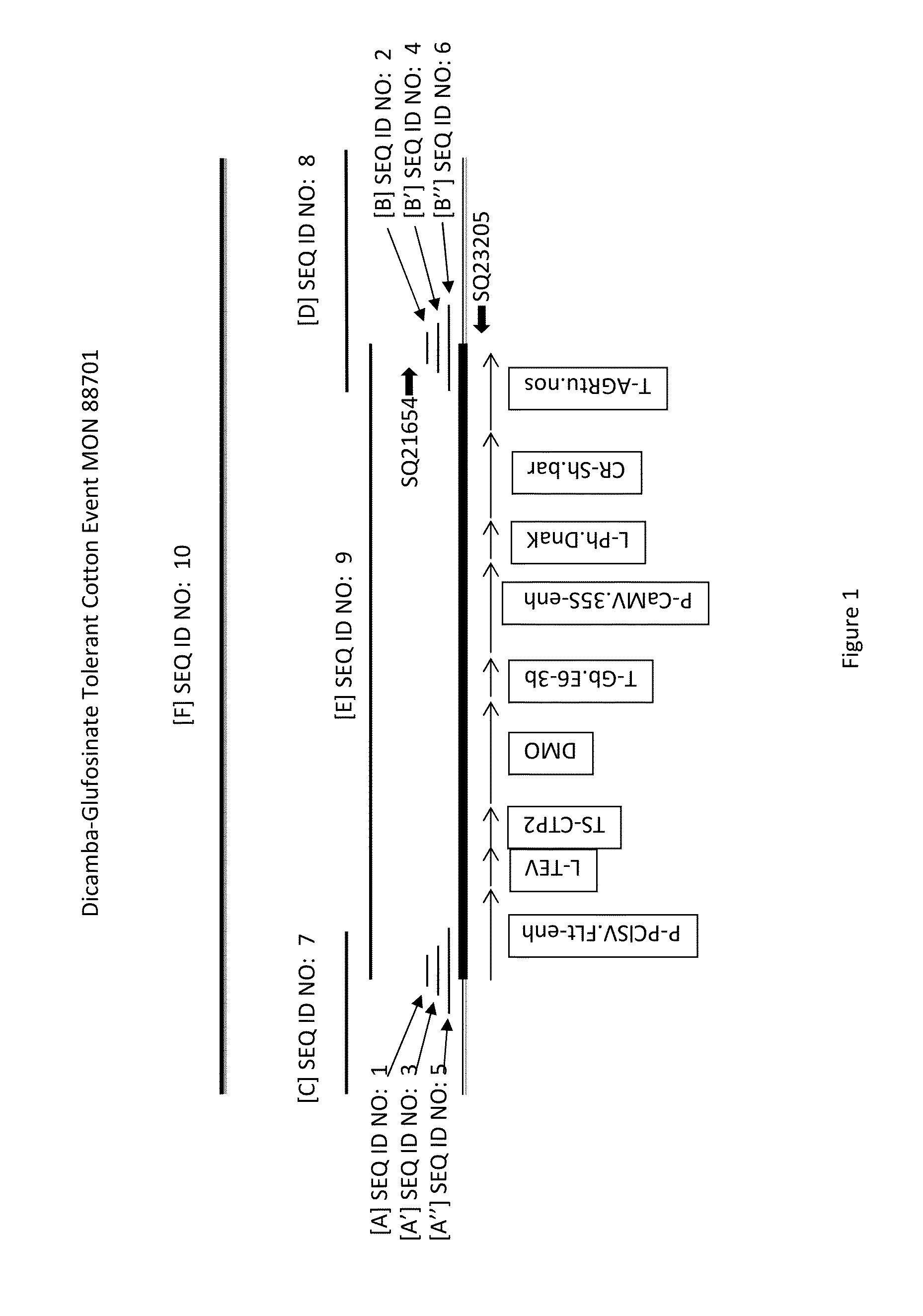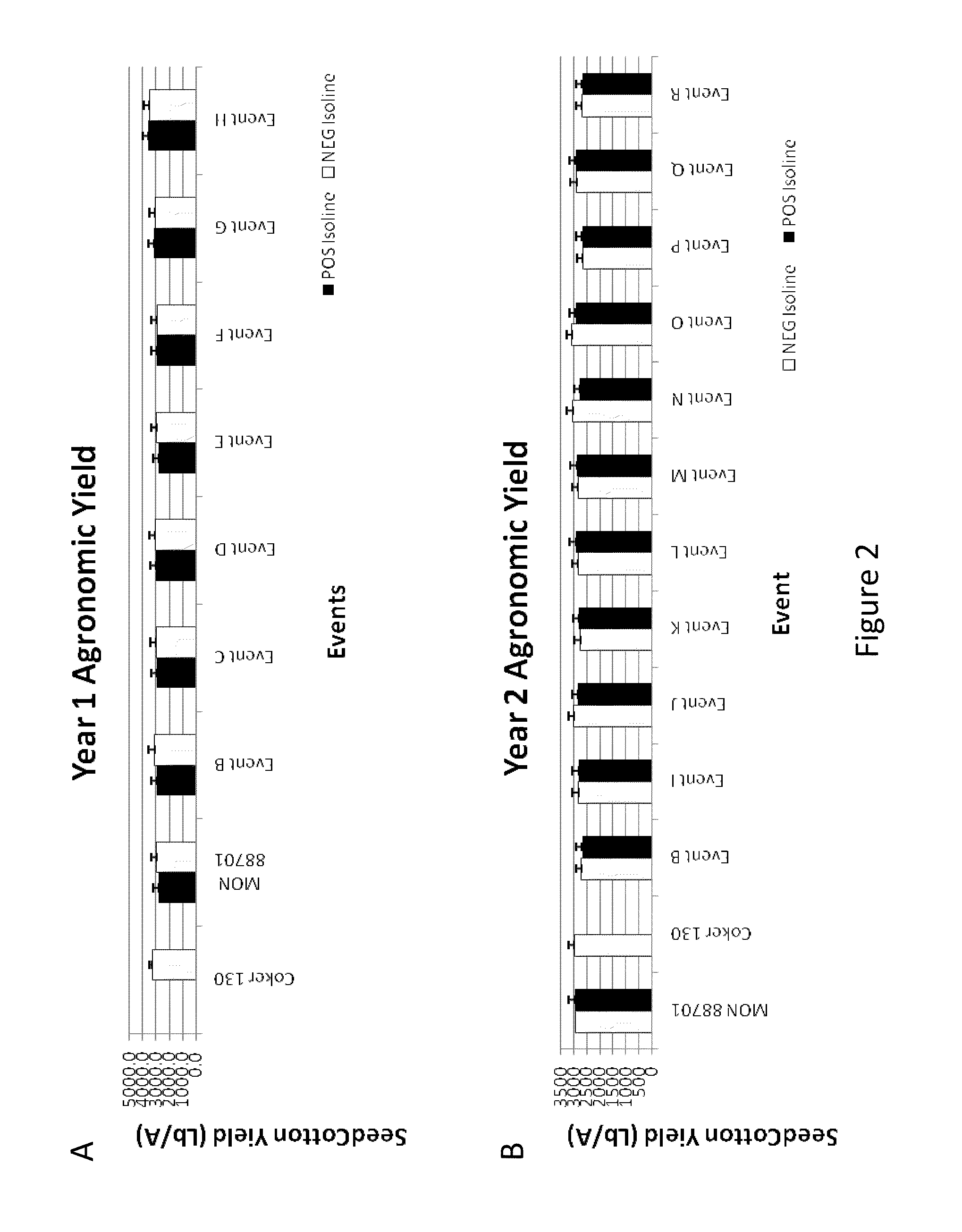Cotton transgenic event MON 88701 and methods of use thereof
a technology of gossypium hirsutum and transgenic event, which is applied in the field of transgenic gossypium hirsutum event mon 88701, can solve the problems of unsatisfactory and/or desirable effects
- Summary
- Abstract
- Description
- Claims
- Application Information
AI Technical Summary
Benefits of technology
Problems solved by technology
Method used
Image
Examples
example 1
Transformation of Cotton and MON 88701 Event Selection
[0076]This example describes the production, analysis, and selection of event MON 88701. Summarized is the production and analysis of thousands of individual plants over multiple years through the rigorous molecular, phenotypic, and field testing required for the ultimate selection of the commercial event, the MON 88701 event.
[0077]The transgenic dicamba and glufosinate tolerant cotton event MON 88701 was created through Agrobacterium-mediated transformation of cotton hypocotyl tissue utilizing a plant transformation vector comprising the expression cassette illustrated in FIG. 1. Methods for transforming cotton are known in the art. To produce the MON 88701 event, Coker 130 cotton material (Asgrow, St Louis, Mo.) was used for plant transformation. Cotton cells were transformed and regenerated into intact cotton plants. Rooted plants with normal phenotypic characteristics were selected and transferred to soil for growth and furth...
example 2
Characterization of MON 88701 DNA Sequences
[0091]This example describes the molecular characterization of the MON 88701 event. The DNA inserted into the genome of cotton plants comprising MON 88701 and the genomic sequence flanking this insertion were characterized by detailed molecular analyses. These analyses included: the insert sequence, the insert number (number of integration sites within the cotton genome), the copy number (number of copies of transgene DNA within one locus), the integrity of the inserted gene cassette, the flanking sequences, and the association of the insertion with haplotype regions of the cotton genome.
[0092]Molecular DNA probes were used that included the intact coding region and its respective regulatory elements, the promoters, introns, and polyadenylation sequences of the plant expression cassettes. The analysis showed that MON 88701 contains a single transgene DNA insertion with one copy of the expression cassette. Inverse PCR and DNA sequence analys...
example 3
Event Specific Endpoint TAQMAN® Assays
[0096]This example describes an event specific endpoint TAQMAN® thermal amplification method developed to identify event MON 88701 in a sample. Examples of conditions useful with the event MON 88701 Specific Endpoint TAQMAN® method are as follows: Step 1: 18 megohm water adjusted for final volume of 10 μl. Step 2: 5.0 μl of 2× Universal Master Mix (dNTPs, enzyme, buffer) to a 1× final concentration. Step 3: 0.5 μl Event Primer-1 (SQ21654) and Event Primer-2 (SQ23205). Mix (resuspended in 18 megohm water to a concentration of 20 uM for each primer) to 1.0 μM final concentration (for example in a microcentrifuge tube, the following should be added to achieve 500 μl at a final concentration of 20 uM: 100 μl of Primer SQ21654 at a concentration of 100 μM; 100 μl of Primer SQ23205 at a concentration of 100 μM; 300 μl of 18 megohm water). Step 4: 0.2 μl Event 6-FAM™ MGB Probe PB10280 (resuspended in 18 megohm water to a concentration of 10 μM to 0.2 μ...
PUM
| Property | Measurement | Unit |
|---|---|---|
| time | aaaaa | aaaaa |
| pH | aaaaa | aaaaa |
| pH | aaaaa | aaaaa |
Abstract
Description
Claims
Application Information
 Login to View More
Login to View More - R&D
- Intellectual Property
- Life Sciences
- Materials
- Tech Scout
- Unparalleled Data Quality
- Higher Quality Content
- 60% Fewer Hallucinations
Browse by: Latest US Patents, China's latest patents, Technical Efficacy Thesaurus, Application Domain, Technology Topic, Popular Technical Reports.
© 2025 PatSnap. All rights reserved.Legal|Privacy policy|Modern Slavery Act Transparency Statement|Sitemap|About US| Contact US: help@patsnap.com



